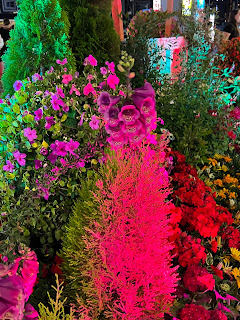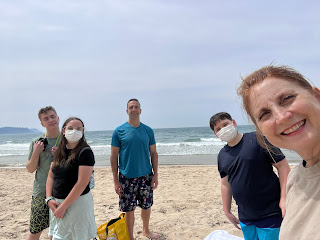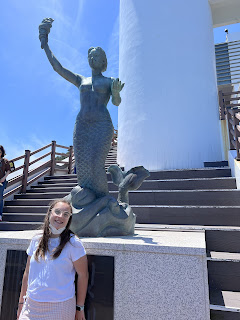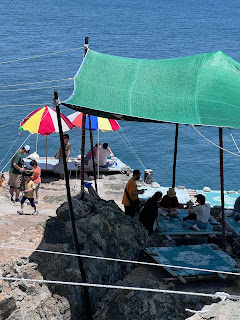A few months ago I ran across something for the 해운대모래축제 Haeundae Beach Sand Festival in May and I knew we had to go. This annual festival first began in 2005. I have not heard of it our first couple years here because it was cancelled, because, Covid. Thousands of people visited the sculptures this year.
The theme was Travel The World With Sand.
The sand artists create the artworks based on a theme that changes each year. The theme this year had recreations of world famous landmarks, with the idea that you can enjoy international sights that Corona 19 has halted.
 |
| Mount Rushmore, Golden Gate Bridge, Statue of Liberty: North America |
It seems that cities and towns in Korea like to brag about their attractions by being 'the most' something: the longest, the oldest, the tallest, the heaviest, etc. Busan Sand Festival proudly takes ownership of being the only eco-friendly exhibition based on sand in Korea. It uses sand to create the artwork, which then goes back to the beach once the festival is done.
 |
| Rapa Nui, Christ the Redeemer: South America |
This sculpture is based on a Roman Catholic cathedral that has been under construction in Spain since 1882. Over 4.2 million people visit it each year.
 |
| Holy Family Cathedral: Spain |
 |
| Tower Bridge, The Gherkin: United Kingdom |
The Eiffel Tower was the highest monument in the world at the time it was built. It was actually criticized by French intellectuals at the time because they felt the block of steel did not match the elegant streets of Paris.
 |
| Eiffel Tower: France |
 |
| Mona Lisa, the Colosseum, the Vatican Cathedral, Leaning Tower of Pisa: Italy |
The Shewdagon Pagoda is regarded as a sacred place for Buddhism in Myanmar. It measures in at 99 meters high with a real gold exterior. The queen of the ancient dynasty donated as much gold as her own weight. The top of the tower is covered with thousands of diamonds.
 |
| Shewdagon Pagoda: Myanmar |
King Sejong sits beside Sungnuemun Gate at Namdaemun. King Sejong is honored for inventing the Korean alphabet for the entire country to become literate.
 |
| Namdaemun and King Sejong: South Korea |
The largest mosque in the United Arab Emirates resides in Abu Dhabi. It is famous for having the largest Persian carpet in the world. It is one of the largest mosques in the world, having 82 white domes.
 |
| Grand Mosque: UAE |
Measuring in at 15 meters, this is the largest creation on the beach. This piece is the culmination of the entire Travel The World With Sand theme. The inspiration of this sculpture, as well as the theme this year, was from lack of travel, because, Covid. It is meant to send messages of comfort and peace to the Korean people who are not yet free to travel. The Empire State Building sits at the top, with the Statue of Liberty and NY trade buildings below.
Big Ben and Greece's Parthenon adorn yet another side.
This piece is labeled Holiday in Rome. It contains scenes from the movie Roman Holiday. Gregory Peck and Audrey Hepburn are riding a scooter in front of the Trevi Fountain. The sign reads "We hope that visitors will regain their smiles while looking at the Italian landscape. Let's go on vacation together at the Busan Sand Festival this summer!"
"One world, one us. Shall we go on a trip aboard the sand boat? Travel and make fun memories!"
There is also an amateur competition. This is an amateur creation. Not too shabby for amateurs.
 |
| Pyramids: Egypt |
The artist of this amateur exhibit recalled laughing and chatting while playing board games with friends and family. Among them, 'Blue Marble' was a game that allowed them to know the characteristics of various parts of the world.
During the outbreak of the Korean War, Busan was a city of refuge. It served as a landing base for UN forces. It is the only city in the world with a UN Memorial Park that enshrines the UN heroes of 22 countries who died in the Korean War.
 |
| 6.25 War Veterans of the World Meet In Sand: Busan |
 |
| Taj Mahal: India |
Ankor Wat is not only the largest temple in Cambodia, but in the world as well. Supposedly it is the most visited landmark by Korean tourists.
 |
| Ankor Wat: Cambodia |
Korea is looking forward to hosting the World Expo in a few years.
 |
| The Parthenon: Greece |
 |
| Pyramids: Egypt |
Our friends The Hackers were also in town for the festival, so we joined forces for dinner.
 |
| Zeke, Daisy, Elayna, Trish, Abe, Dave, Ashlee, Gavin and Eli |
After dinner (and a few drinks) we went to Haeundae Square. This area is a 490 meter long stretch of road between Haeundae Beach and the subway station, with a four-lane road divided by a 30 meter wide pedestrian-oriented cultural plaza. The area attracts many locals and tourists alike with restaurants, shopping, street performances, a food alley and an art market.
We tried our aim at darts.
We also ventured into the food alley.
The only thing we ate at the food alley was bubble gum. The food choices were local food from the ocean. Not our cup of tea. But the all the kids loved their Hubba Bubba that they found in a little shop.
Along with the sand festival, flower exhibitions at Hauendae Square decorate the center pedestrian aisle. This exhibition is held to help flower farmers in Busan and it covers the whole street with 130,000 flowers of 16 types.
It is quite amazing.
Daisy and her friends spend time with Elayna and her friends at school during their lunch break.
We stepped into a photo booth store. They are quite common here and a whole lot of fun.
This is the same place we visited at Christmas time with the big Christmas tree that has been replaced with a flower windmill.
On the walk back to the hotel we strolled through the sand sculptures to check them out at night.
The next morning Abe and I enjoyed a walk along the beach. We came across workers cleaning up from the night before. This trailer is full of cardboard to recycle.
I appreciate the way the beach is kept tidy.
A breakwater was added at the coast of Hauendae Beach as part of coastal maintenance to prevent the loss of sand. Being invisible above water, ships would collide with it if it were not marked. That sculpture in the water is called 'Looking At The World' and it warns ships to avoid the danger below.
This little lady is called the Princess 황옥 Hwangok Statue. The original mermaid statue was erected 1974 but destroyed by typhoon Thelma in 1987. The new bronze statue, erected in 1989, is 2.5 meters tall and weighs 4 tons. There is a sad story that goes with the statue. Princess Hwangok crossed the sea from a mermaid country to marry King Eunhe of Mugung. She suffered from homesickness but was comforted every full moon by looking at the reflection of her country on a topaz bed, which is what hwangok means.
The characters on this rock are said to have been written and inscribed by the great poet and scholar 최치원 Choi Chi Won of the late Silla period in the 1390s. He was struck by the beauty of the sea (hae), the clouds (un) and the hills (dae), thus resulting in the name Haeundae.
We continued our walk through 나루공원 Naru Park.
Choi Chi Won is memoralized here in Naru Park.
After our long walk, these guys were still zonked out.
We stirred them from the dead to go to Oryukdo. 오룩도 Oryukdo Islands is actually a cluster of islands. The name literally means 'five six islets,' because at times you can see five islands and at times you can see six. Viewing them from the east, there appear to be six peaks, but from the west they become five peaks.Each of the islets has a cute little name. The one closest to the mainland is called 벙패섬 Bangpaeseom (shield islet, since it is believed to block strong wind and waves), 솔섬 Solseom (pine islet due to a pine tree growing on top), 수리섬 Suriseom (eagle islet, since eagles gathered on this islet to hunt seagulls), 송곹섬 Songgotseom (awl islet due to its start shape), 굴섬 Gulseom (cave islet because a cave is located in the middle), and 등대섬 Deungdaeseom (lighthouse islet since there is a lighthouse on it).
Around 120,000 years ago these islets were part of a small peninsula connected to the mainland; due to erosion by strong waves, however they got separated and became islets.
The Oryukdo Skywalk is a 15-meter long glass bridge composed of 24 glass panels linked to each other in a horseshoe shape. The iron beams rest 35 meters above the sea on a cliff. You can see it poking out from the cliff on the top left side.
The skywalk was built to view the islands, but oddly enough you can't really see all five or six of them from this angle. It looks more like two. After some study and viewing them from different angles I located all six.
The name 승둠알 Seungdumal was the original name of the area that marks the border between the East and South Seas. That name means saddle, due to the shape of the point. The name Oryukdo Skywalk, meaning 'walking over the sky,' was given to the observation deck at its opening in 2013.
The islands are drawn on the stones.
Haeundae Beach is the most famous beach in Busan (there are seven public beaches). The soft sand is roughly 1.5 km long, creating a beautiful coastline with a shallow bay for swimming.
We had not yet been swimming in Haeundae since moving here, and if it didn't get done on this trip it was not going to get done. The temperature had been quite warm several days prior, but it was a bit chilly this day. And the water was freezing. But we gotten anyway and checked something else off our list.
After swimming, Daisy and I took the metro to the mall in search of the elusive prom dress, which, by the way, we were successful! We passed the beautiful flower displays at Haeundae Square in the daylight on the way to the metro.
As we were nearing the beach we could see the drones in the air for a few minutes. When we got to the street to cross, massive crowds were coming at us. Turned out we missed the show. We got to see the drones lined up on the ground.
광안대교 Gwangan Bridge is well-known. It is South Korea's longest double-deck bridge with a length of 4.6 miles. What makes it stand out at night is the 7,000+ LED lights that change colors as they illuminate the bridge. Interesting side note: the bridge was used in the filming of the movie Black Panther.
The Pops snuck back to the hotel after dinner the first night, so we had to take more night photos of him with the flowers.
This is the view of Gwangan Bridge from the opposite side, from our hotel. A pretty view from both sides.
You could also see the sand sculptures from the hotel room.
Remember the breakwater sign from the morning walk? The next morning Abe and I walked the opposite direction. There is another sculpture on the other end of the beach. While the other one depicts a person looking at the world, this one depicts a person "jumping into the world." I think something isn't translating quite right with this description.
This hardworking lady was drying her sea weed that she had collected that morning.
The Stairway To Heaven, as these are referred to.
The Gwangan Bridge by day.
Here are the Oryukdo Islands from the East Sea. I little easier to see each island.
I love walking on the beach, discovering treasures that have been washed on shore.

Our final stop of this trip was 태종대 Taejongae Park. It is located on the southernmost tip of the island of Yeongdo an is roughly 1.6 million square meters, or 395 acres.
We boarded the 다누비 Danubi Train to drive us up to the cliffs. Danubi translates to 'admiring the scenery.'
The first stop was the Taejongae Observation Deck.
You get a good view of Kettle Island from there. It is supposedly named after its shape, but I don't really see the kettle shape.
They say on a clear day you can see 대마도 Daemado Island, which is part of Japan. If you zoom in, it looks like it could be an island on the left.
The observatory is located at the top of a high cliff.
Apparently many people died by suicide at this cliff by jumping off. So many the rock was called 자살바위 Jasal Bawi, or Suicide Rock. So many that a statue called 모자상 Mojasang, or The Statue of Mother and Children, was erected here in 1976. The plaque reads that the statue "helps remind those who are about to commit suicide, by jumping from Taejongdae's cliff, of their mother's unconditional love for them, and will hopefully encourage them not to give up on life." A temple was built nearby to console the spirits of the dead.
Apparently many people died by suicide at this cliff by jumping off. So many the rock was called 자살바위 Jasal Bawi, or Suicide Rock. So many that a statue called 모자상 Mojasang, or The Statue of Mother and Children, was erected here in 1976. The plaque reads that the statue "helps remind those who are about to commit suicide, by jumping from Taejongdae's cliff, of their mother's unconditional love for them, and will hopefully encourage them not to give up on life." A temple was built nearby to console the spirits of the dead.
On a much lighter note, I'm not sure what this is all about.
'The Spirit of the Sea' monument honors historic seafarers.
'The Ocean Charter' explains on the base that Korea vows to be a maritime nation that protects the ocean. It also describes their deep understanding of the importance of the ocean, since it has been their source of life, peace, and prosperity, as well as their gateway to the world.
Next comes the iconic circle monument. It's called 'Light Beyond Limitation.' The blue refers to the sky and sea, while the red refers to the sun, camellia flower, universe, five oceans and six continents. The silver bar pointing to the sea symbolizes the light from the lighthouse that splits the sea and sky. The bar also expresses 'an ascending marine nation.'
영도 Yeongdo Lighthouse has been shining its beacon since 1906. It is the oldest lighthouse in Busan and the 10th oldest in South Korea and proudly stands 35 meters tall.
There is a rock called 망부석 Mangbuseok, or Rock of the Faithful Woman, that represents the legend of a woman who waited for the long return of her husband. He had been captured by the Japanese and taken hostage to Japan. It is said she stood watching over the ocean so long she turned to stone.
King Taejong, who was the 29th King of the Silla Dynasty, enjoyed the island and greatly appreciated the scenery. The name Taejongdae was derived from the king. It is said that he practiced shooting his bow and arrow here. He also would come to pray for rain during a drought; rain on the 10th day of the 5th lunar month is still called "Taejong Rain.
Down the stairs from the lighthouse sets cute little umbrella-covered places to have a picnic with seafood that was just taken from the ocean. Not for me, but if one liked seafood it would be the perfect place for a picnic.
Taejongdae is thought to have been a lake 90 million years ago. The cliffed coast was created 73 million years ago when volcanoes erupted, and continued to be formed with weathering and erosion.
As you can tell, it was quite windy. Messy hair, don't care.
The final stop of the island was 태종사 Taejongsa Temple.
A Buddhist stupa, which is a sacred relic, was donated by the Sri Lanken government as a sign of friendship. The relic is 2,500 years old.
That's it for our fun-filled Busan weekend.
[May 27-29]




































































































































































































No comments:
Post a Comment